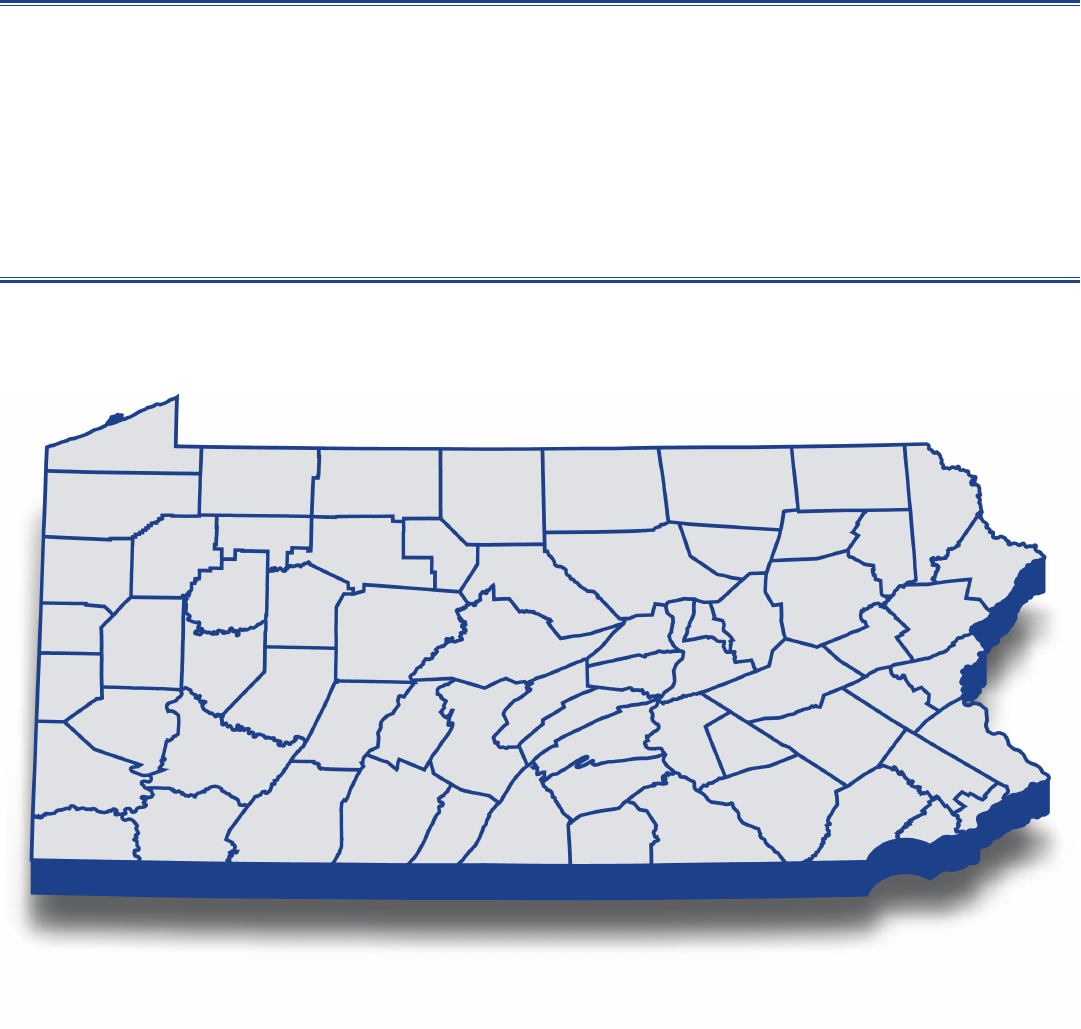
Pennsylvania Teacher
Stang Challenges
Fall 2022
Ed Fuller, Ph.D.
Department of Education Policy Studies
College of Education
The Pennsylvania State University

Center for Evaluation
and Education Policy Analysis
The mission of the CEEPA is to provide unbiased, high-quality evaluation and policy analysis services
to education and other organizations in the Commonwealth of Pennsylvania and across the nation.
Prepared by Annemarie Mountz

4 Penn State College of Education Center for Education Evaluation & Policy Analysis
Table of Contents
Executive Summary .................................................................................................................................... 5
Introduction ................................................................................................................................................... 6
Potential Factors Influencing Teacher Stang Challenges in Pennsylvania ..............................10
Demand for Teachers from Attrition ............................................................................................10
Demand for Teachers from Student Enrollment .......................................................................12
Supply of Teachers ........................................................................................................................... 13
Employing Newly Certified Teachers...........................................................................................15
Hiring Additional Teachers and Support Personnel ................................................................15
Impact of Teacher Stang Challenges .................................................................................................16
Potential Causes .........................................................................................................................................19
Potential Solutions .....................................................................................................................................21
Summary ......................................................................................................................................................22
References ..................................................................................................................................................23

Penn State College of Education Center for Education Evaluation & Policy Analysis 5
Executive Summary
• Pennsylvania is facing a severe teacher stafng challenge, although the severity varies by school
subject area, region of the state, and school characteristics.
• There are now more Pennsylvania teachers on emergency permits than newly certied teachers
from Pennsylvania teacher preparation programs.
• While challenges exist in all subject areas, the need for new and well-prepared teachers is most
acute in the following areas: special education, English Language Learner (ELL), foreign language,
general elementary, English language arts, mathematics, and science.
• There are teacher preparation program “deserts” in Pennsylvania that exacerbate the challenges
faced by rural schools.
• There is a severe shortage of teachers of color with few preparation programs graduating more
than a handful of teachers of color each year. This negatively impacts the educational attainment of
students of color.
• Teachers of color — especially Black teachers — have greater attrition rates than their white
counterparts.
• Attrition and turnover rates in charter schools are extraordinarily high.
• Stafng challenges in Pennsylvania appear to be caused primarily by an inadequate supply of
newly certied teachers and, to a lesser extent, a greater than expected number of educators hired
over the last four years in response to increased educational and mental health needs of students
stemming from the pandemic.
• Teacher stafng challenges are felt most acutely by schools serving high proportions of students
living in poverty and students of color.
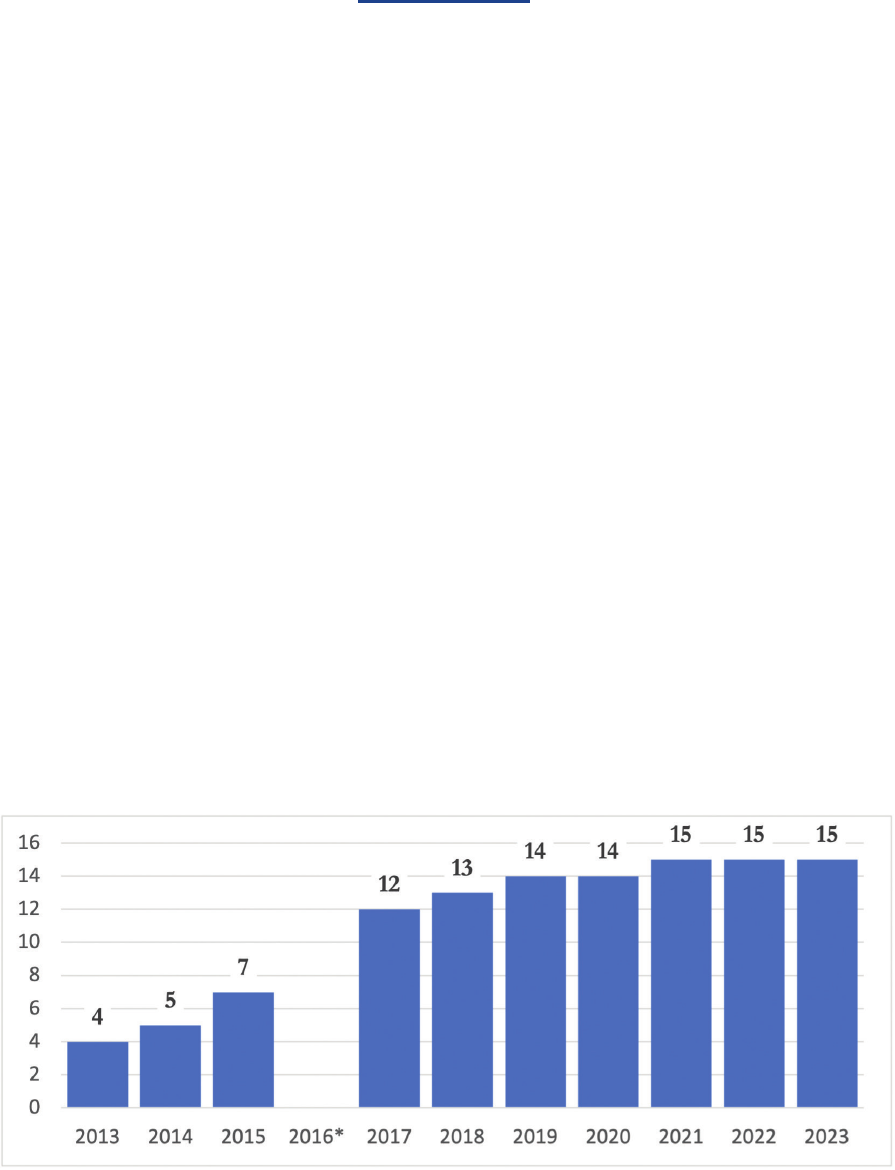
6 Penn State College of Education Center for Education Evaluation & Policy Analysis
Introduction
There is a strong research consensus that
teachers are the most important school factor
in improving student outcomes (Nguyen, et al.,
2019). An ample supply of well-prepared teachers
and relatively low teacher turnover are key issues
related to the overall quality of a state’s teacher
workforce. This study examines the degree to
which the supply and retention of teachers is
adequate for the Commonwealth to ensure every
child has access to well-qualied teachers.
Historically, Pennsylvania has been known as
an exporter of teachers and has rarely been
mentioned as a state experiencing teacher
labor market challenges in areas other than
mathematics, selected science courses, ELL
instruction, and special education.
Recent news stories and evidence, however,
report that many districts are facing challenges in
fully stafng schools with any teachers, much less
well-qualied teachers. These growing challenges
are negatively affecting the educational
opportunities of a growing number of students,
especially students living in poverty, students
of color, and students living in rural areas of the
Commonwealth.
Unfortunately, there is no common definition of a “teacher
shortage” and there are few, if any, direct measures
of a “teacher shortage” that are currently available to
understand the specific nature of the challenges.
In Pennsylvania, there are several indicators of
teacher labor market challenges. One indicator is
the list of designated shortage areas identied by
the Pennsylvania Department of Education (PDE)
and provided to the United States Department
of Education (USDoE). Over the last decade, the
number of subject areas identied as having a
shortage has expanded (see Figure 1).
For the last three years, there have been
designated shortages for: elementary, middle,
and high schools; 15 of the 23 possible areas;
and every single subject area other than gifted
education.
Figure 1: Number of Designated Teacher Shortage Areas in Pennsylvania by Year
Data source: USDoE teacher shortage reports
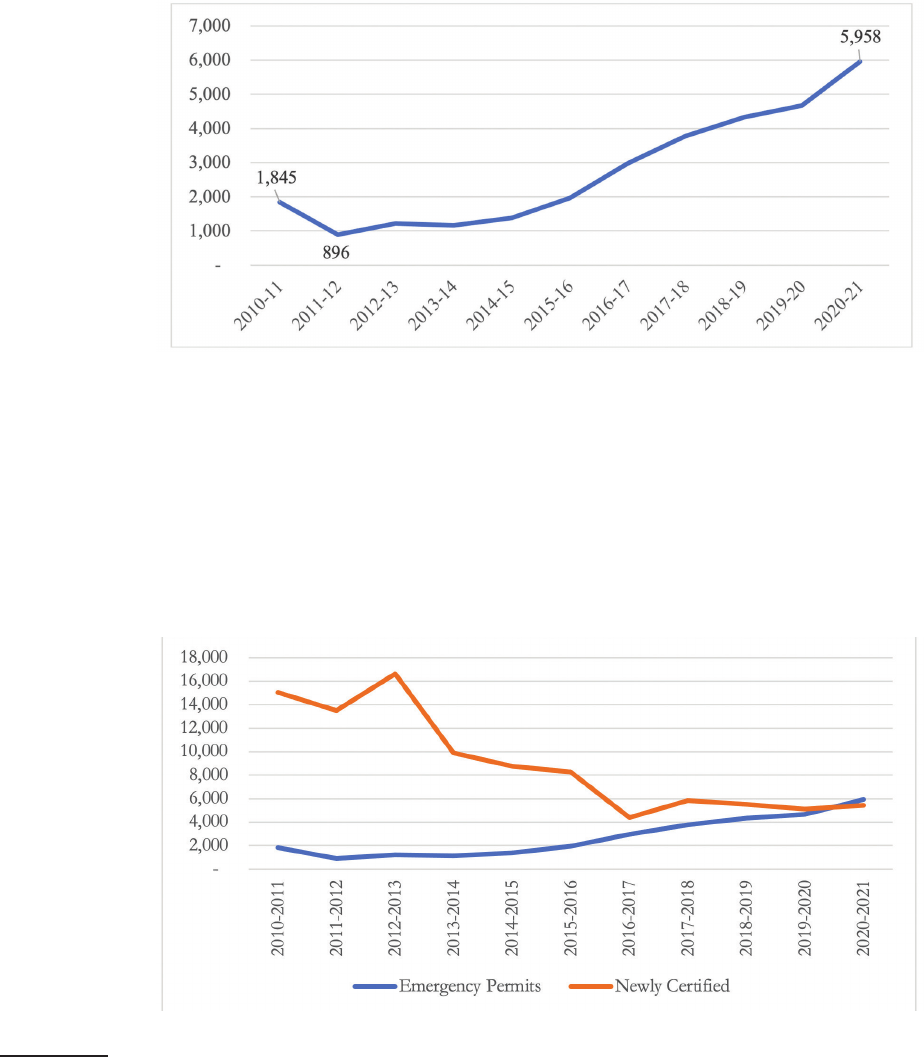
Penn State College of Education Center for Education Evaluation & Policy Analysis 7
Another indicator is the number of teaching
positions lled by individuals on an emergency
permit — either on an emergency permit because
the person does not hold the appropriate teaching
certicate for their teaching assignment (Type 01)
1
or because the person is a long-term substitute
(Type 04). In either case, research suggests that
students suffer academically when taught by
a teacher on an emergency permit (Goldhaber,
2012).
As shown in Figure 2, there has been an increase
of more than 5,000 positions that could not be
lled by a properly certied teacher from 2011-
12 to 2020-21. Thus, the number of students
taught by an inadequately prepared teachers has
increased dramatically.
Figure 2: Number of Teaching Positions Filled by Individuals on an Emergency Permit (2011-12 to 2020-21)
Data source: Act 82 Report from PDE
This number is even more concerning when we
compare the number of newly certied teachers
from Pennsylvania teacher preparation programs
(TPPs) to the number of teaching positions lled
by individuals on emergency permits (see Figure
3, below).
For the first time in the history of the Commonwealth, the
number of newly certified teachers was less than the number
of teaching positions filled by teachers on emergency
permits.
Figure 3: Comparison of Number of Newly Certified Teachers to
Number of Teaching Positions Filled by Individuals on an Emergency Permit
Data source: Act 82 Report from PDE
1
According to PDE, “a Type 01 permit is requested for a position that will exceed 20 consecutive days in a single assignment
when the Local Education Agency (LEA) anticipates future employment for the position.” Following are examples of
qualifying vacancies: New Position; Resignation; Termination; Retirement; Death.

8 Penn State College of Education Center for Education Evaluation & Policy Analysis
Figure 4 documents the increase in the
percentage of positions lled by individuals on
emergency permits by major subject area from
2012-13 through 2020-21. For all eight major
subject areas, the percentages of teachers on an
emergency permit in 2020-21 were at least twice
the corresponding percentages in 2012-13. For ve
of the subject areas (elementary, English language
arts, ne arts, and physical/health education), the
percentages of teachers on emergency permits
in 2020-21 were at least ve times greater than
in 2012-13. If we assume elementary teachers
are assigned to teach 15 students per year
and secondary teachers are assigned to teach
100 students per year, the increase in the use
of educators on emergency permits affects
approximately an additional 200,000 students
in 2020-21 than in 2012-13. A disproportionate
percentage of these students are likely students of
color and students living in poverty.
Figure 4: Percentage of Teaching Positions Filled by Individuals
on an Emergency Permit (2012-13 through 2020-21)
Data source: Author calculations based on data from PDE’s Act 82 Report

Penn State College of Education Center for Education Evaluation & Policy Analysis 9
Figure 5: Ratio of the Number of Newly Licensed Teachers to the Number of Beginning Teachers
by Major Subject Area and Year (2013-14 to 2020-21)
Data source: Act 82 Report from PDE
Another indicator of teacher stafng challenges
is the ratio of the number of initial in-state
Instructional I licenses granted by PDE to the
number of beginning teachers hired in the same
subject area. This ratio captures the comparison
of the supply of teachers in a subject area to the
demand for newly licensed teachers in the same
subject area. A ratio of 1.0 indicates the number
of newly certied teachers is equal to the number
of beginning teachers hired. The greater the ratio,
the greater the supply of teachers and, all other
things equal, the larger the potential applicant
pool. Conversely, the smaller the ratio, the smaller
the supply of teachers and, hence, a smaller
potential applicant pool.
This is important because the larger the applicant
pool, the more likely a district will be able to
hire a well-qualied teacher who ts the vacant
position. Research suggest this increases the odds
the teacher will be effective and remain in the
position.
As shown in Figure 5, the overall supply-demand ratio
of the number of new Instructional I licenses to the number
of beginning teachers hired in Pennsylvania school districts
has declined substantially from 2013-14 to 2020-21 for all
major subject areas.
By 2020-21, only the supply-demand ratios for
elementary and social studies positions were
greater than two newly certied individuals to
one beginning teacher hired. For ve of the nine
major subject areas (secondary mathematics,
secondary science, foreign language, ne arts, and
physical/health education), the supply-demand
ratio declined to 1.1 licenses per one beginning
teacher or lower.
The declines over time and very low ratios strongly suggest
the pool of prospective teachers from which districts hire
beginning teachers has become too small to meet the
demand for beginning teachers.
Evidence that this reduced supply is impacting
district hiring practices is supported by the
greater than 400 percent increase in the number
of teachers on emergency permits from the 2011-
12 to 2020-21 academic years.
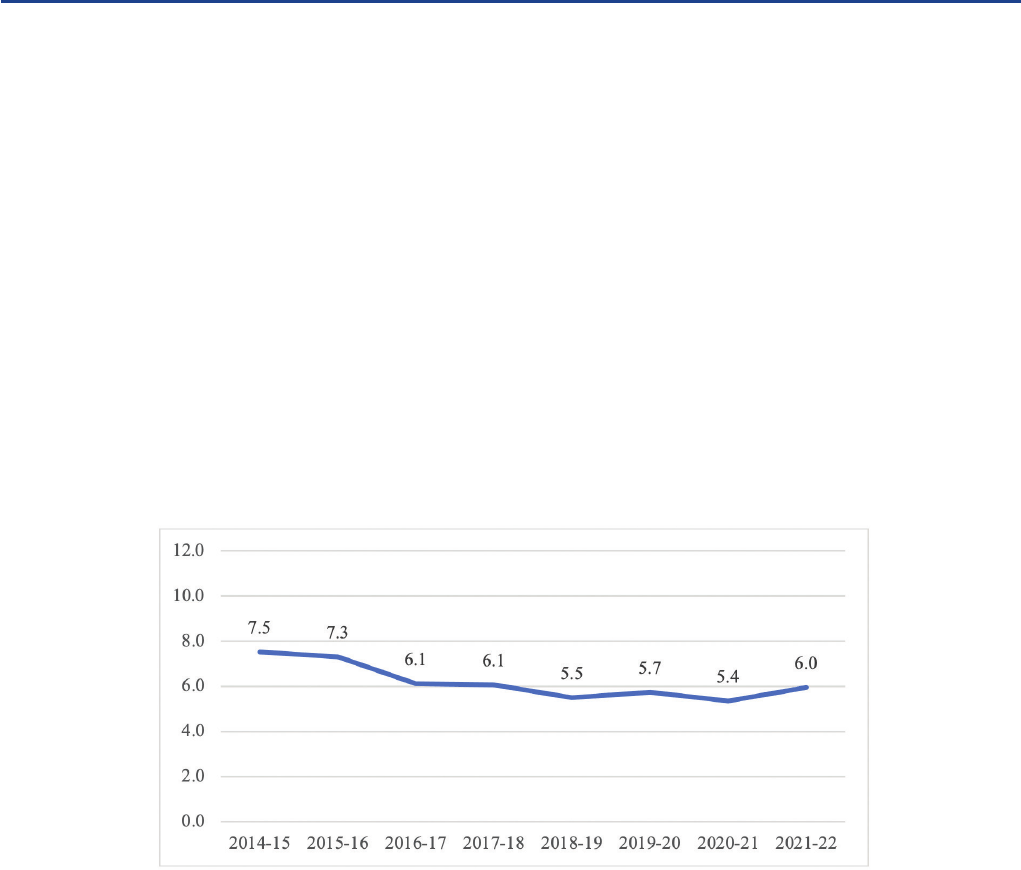
10 Penn State College of Education Center for Education Evaluation & Policy Analysis
Potential Factors Influencing Teacher Stang Challenges in Pennsylvania
Teacher stafng challenges can arise from
multiple causes. Historically, the two primary
causes have been an increase in the demand for
teachers and a decline in the supply of teachers.
An increase in the demand for teachers can stem
from an increase in teacher attrition, an increase
in student enrollment, or a reduction in the
student-teacher ratio to meet the instructional
needs of students.
Demand for Teachers from Attrition
Historically, the primary cause of teacher stafng
challenges is the attrition of teachers from the
profession. Nationally, about 8% of teachers quit
their positions each year. As shown in Figure 6,
the annual teacher attrition rate in Pennsylvania
has always been lower than the national average
and, moreover, has trended downward through
2020-21. In fact, for six consecutive years, the
annual teacher attrition rate for Pennsylvania has
been less than 6.2%. This is about two percentage
points less than the national average for teacher
attrition.
Thus, teacher attrition does not appear to be the primary
driver of the shortage of teachers in Pennsylvania.
Figure 6: Annual Pennsylvania Teacher Attrition (2014-2015 through 2021-22)
Data source: Author’s analysis of PDE educator employment files
Attrition, however, is greater for specic types of
teachers and teachers in specic types of districts.
Consistent with all studies of teacher attrition by
experience, Figure 7 reveals teacher attrition is a
U-shaped curve. Specically, attrition is greatest for
the least and most experienced teachers. Attrition is high
for the least experienced teachers for a variety
of reasons, including inadequate preparation,
insufcient support, poor working conditions,
and low salary. Attrition is high for the most
experienced teachers because they have become
eligible to retire.
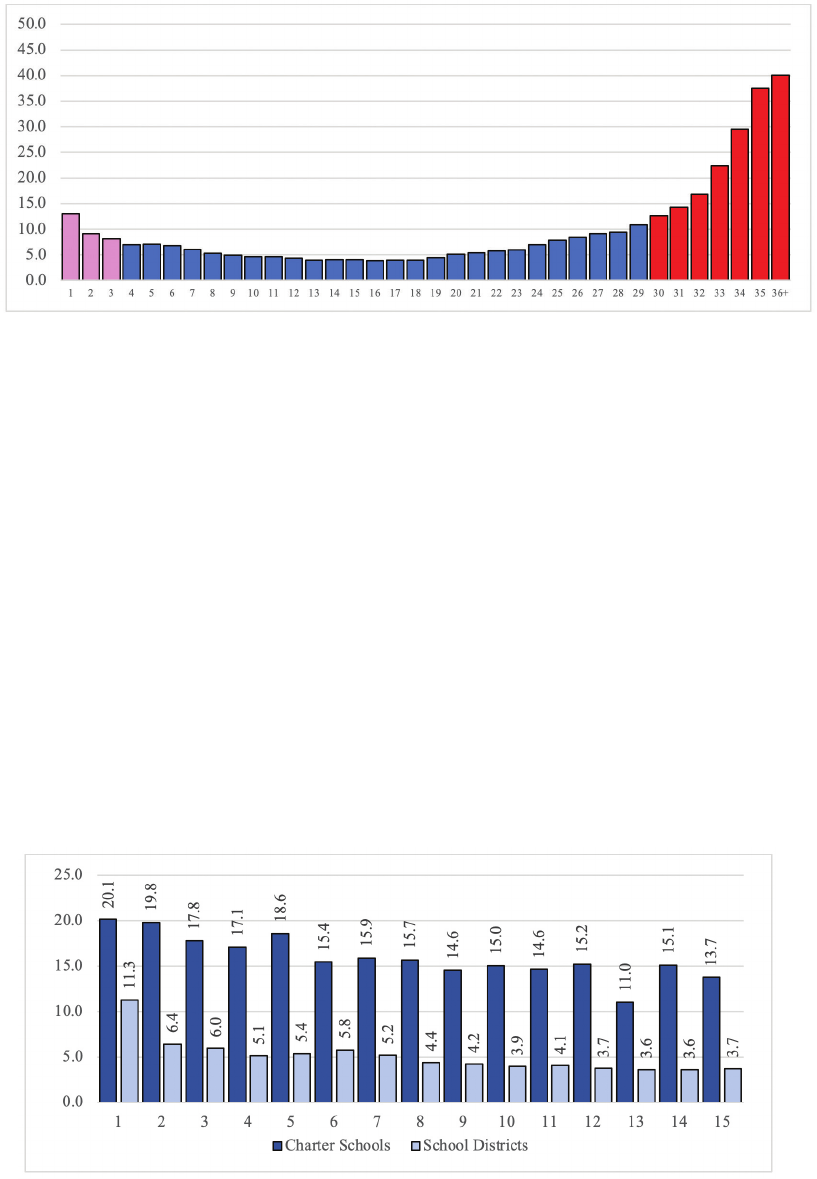
Penn State College of Education Center for Education Evaluation & Policy Analysis 11
Figure 7: Teacher Attrition in Pennsylvania by Years of Experience (2012-2018)
Data source: PDE educator employment files; Analysis by author
Figure 8 shows annual teacher attrition from
2013-2014 to 2017-18 by years of experience for
teachers in school districts and charter schools.
For teachers in their rst year of teaching, 11.3%
of teachers in school districts and 20.1% of
teachers in charter districts left teaching.
Across all 15 years of experience, the attrition rate for
teachers in charter schools was substantially greater than
for teachers in school districts.
Indeed, in years 2 through 15, the attrition rate
for charter schools was at least double the rate
for teachers in school districts. The much greater
attrition rates for teachers in their rst three years
of experience in charter schools is partially due
to the hiring of a substantial number of teachers
without certication. Pennsylvania allows charter
schools to hire up to 25% of their teachers without
a valid teaching certicate. Such teachers have
three years to complete the certication process.
A substantial percentage of such teachers never
complete the certication process. In fact, nearly
38% of beginning teachers in charter schools
quit the profession after their third year of
employment. Only 16% of beginning teachers in
school districts leave teaching after year three.
Figure 8: Annual Teacher Attrition Rate by District Type and Teacher Years of Experience (2012-2018)
Data source: PDE educator data files provided to author; Analysis by author
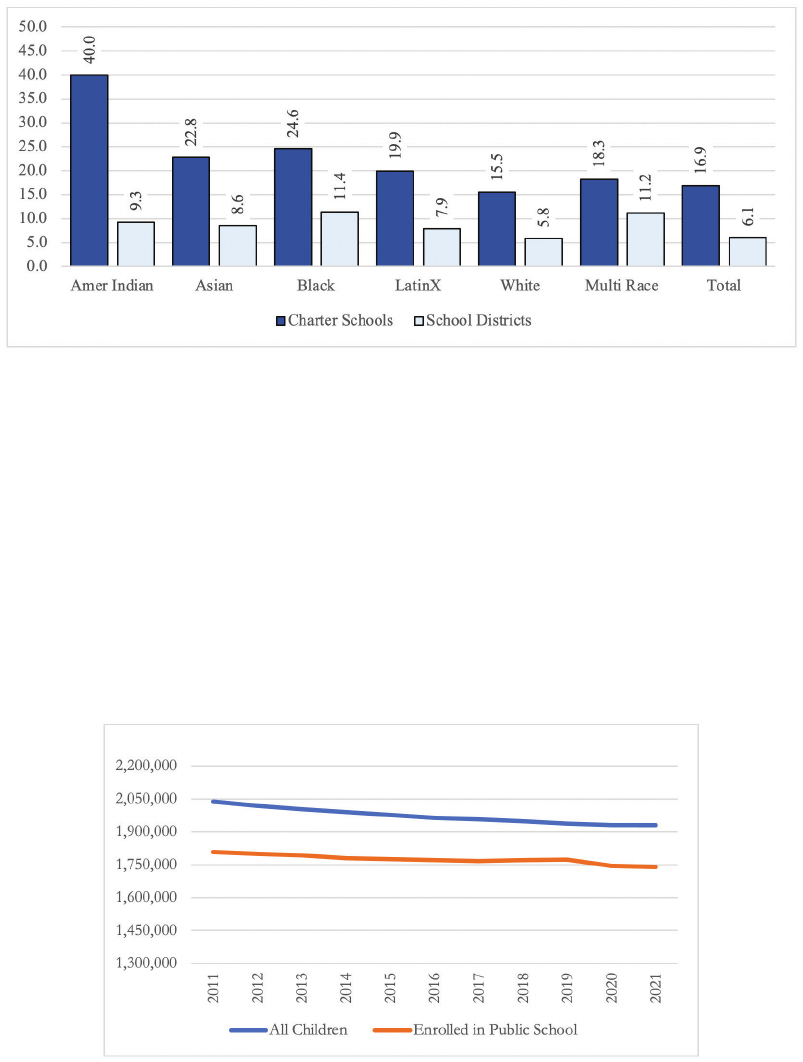
12 Penn State College of Education Center for Education Evaluation & Policy Analysis
A large body of research has found teacher
attrition also varies by race and ethnicity (Nguyen,
et al., 2019). This is also true in Pennsylvania as
shown in Figure 9. For teachers in school districts
and charter schools, the very small population of
American Indian/Alaskan Native (AIAN) teachers
had the greatest attrition rates with Black
teachers having the second highest rates.
In charter schools, the annual attrition for Black teachers
was nearly 25% while the rate for white teachers was
15.5%. In school districts, the annual attrition rate for Black
teachers was 11.4% which was more than five percentage
points greater than for white teachers.
The attrition rates for LatinX teachers were also
greater than for white teachers although the
differences were smaller than between Black and
white teachers.
Figure 9: Annual Teacher Attrition Rate by District Type and Teacher Race/Ethnicity (2012-2018)
Data source: PDE educator employment files provided to Author; Analysis by author
Demand for Teachers from Student Enrollment
Changes in student enrollment can also lead
to changes in the demand for teachers. In
Pennsylvania, as shown in Figure 10, the number
of children in the Commonwealth and the
number of students enrolled in Pennsylvania
public schools has declined over the past decade.
Pennsylvania loses about 10,000 school-aged
children a year due to migration out of state
and changing age demographics. This decline in
population reduces the demand for teachers.
Figure 10: Number of Children Aged 5 to 17 and
Number of Students Enrolled in Public Schools in Pennsylvania (2011- 2021)
Data source: PDE student enrollment reports and Census Bureau ACS data
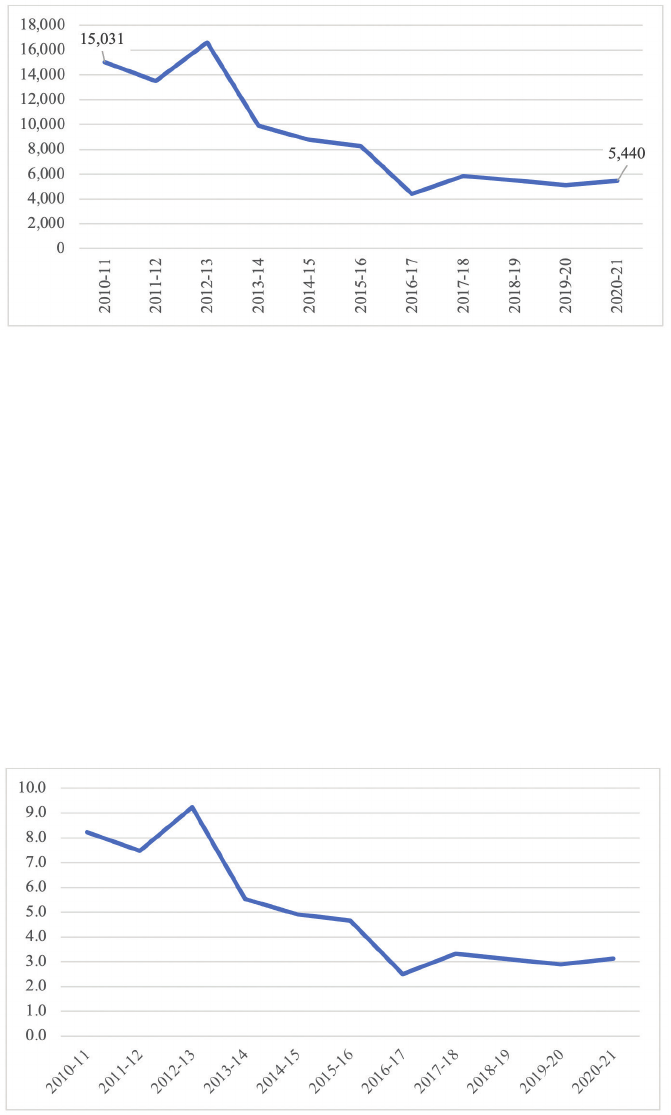
Penn State College of Education Center for Education Evaluation & Policy Analysis 13
Supply of Teachers
An inadequate supply of teachers can also
contribute to teacher stafng challenges. As
shown in Figure 11, there has been a dramatic
decline in the number of individuals obtaining
teacher certication in Pennsylvania.
Indeed, from 2010-11 to 2020-21, the number of initial in-
state certificates awarded declined by 67%.
Figure 11: Number of Initial Teacher Certificates Issued
for Graduates of Pennsylvania TPPs (2011-12 through 2020-21)
Data source: PDE Act 82 report
As shown above, there has been a decline in
student enrollment and a decline in the number
of individuals obtaining teacher certication. It is
possible that the decline in individuals obtaining
certication and the decline in students enrolled
in public schools have occurred in a way to
maintain an adequate supply of teachers for the
number of enrolled students. However, as shown
in Figure 12, the number of individuals obtaining
certication per 1,000 students has declined
precipitously over the last decade.
Thus, the number of individuals obtaining certification is
declining at a faster rate than the decline in the number of
students enrolled in public schools.
Figure 12: Number of Initial Teacher Certificates Issued for Graduates of Pennsylvania TPPs
per 1,000 Enrolled Pk-12 Students (2011-12 through 2020-21)
Data source: PDE Act 82 report
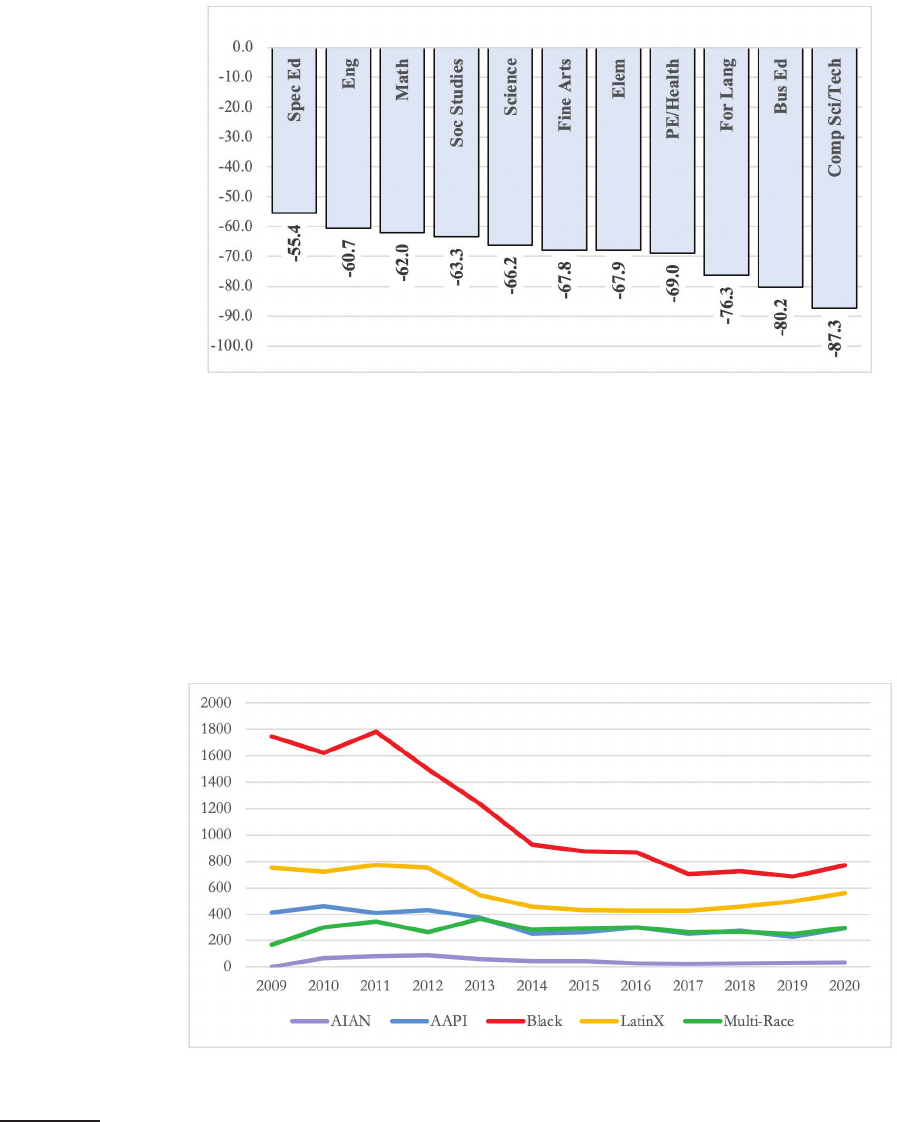
14 Penn State College of Education Center for Education Evaluation & Policy Analysis
This overall decline, however, masks variation by
subject area.
As shown in Figure 13, the greatest declines in the
supply of teachers has been computer science/technology
2
and business education. All of the other subject areas had
declines of 67% or lower.
Interestingly, special education had the smallest
decline at 55%, but the demand for special
education teachers has far exceeded supply.
Figure 13: Percent Change in the Number of Initial Teacher Certificates Issued
for Graduates of Pennsylvania TPPs by Subject Area (2011-12 through 2020-21
Data source: PDE Act 82 report
There has also been a general decline in students
of color enrolled in Pennsylvania TPPs from 2009
to 2021 as shown in Figure 14.
There has been, however, a slight increase in the
number of students enrolled in Pennsylvania TPPs
in recent years. The number of Black students
declined the most — a full 60% decline from 2009
to 2020. The only racial/ethnic group with greater
decline was white students (not shown) with a
68% decline. The last few years of enrollment
data, however, do suggest a positive trend of an
increasing number of students of color enrolled in
Pennsylvania teacher preparation programs.
Figure 14: Number of TPP Enrollees by Race/Ethnicity for Students of Color (2009-2020)
Data source: Author’s analysis of Tile II Data from US Department of Education
2
However, teachers with certication in mathematics or science can technically teach computer science and be considered
properly certied in Pennsylvania. Whether such teachers are effective in teaching computer science is unknown.
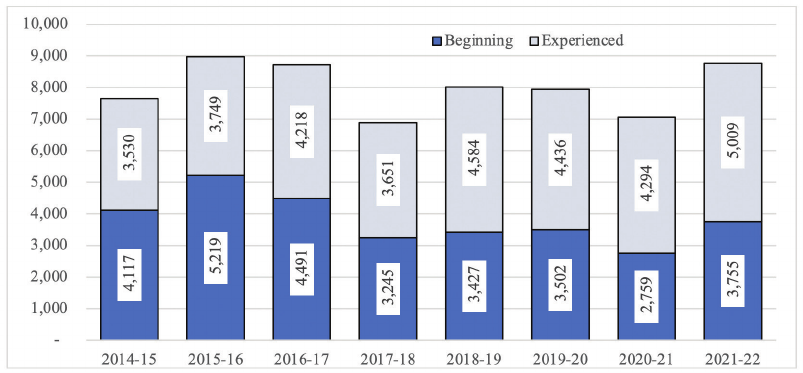
Penn State College of Education Center for Education Evaluation & Policy Analysis 15
Employing Newly Certified Teachers
While preparing an adequate number of newly
certied teachers to meet the demand for new
teachers is obviously important, an additional
factor is the percentage of newly certied teachers
who seek and obtain employment in Pennsylvania
public schools. Unfortunately, current data does
not capture job-seeking behaviors and the data
from PDE does not currently allow for an accurate
calculation of the percentage of newly hired
teachers who become employed in a Pennsylvania
public school. However, using the available data,
I was able to estimate the number of newly hired
teachers who were beginning teachers from 2014-
15 to 2021-22. While beginning teachers did not
necessarily obtain certication in the prior year,
this does serve as a proxy measure for the number
of newly certied teachers obtaining employment
in Pennsylvania public schools. As shown in
Figure 15, the number of newly hired teachers
who were identied as beginning teachers was
substantially lower than the number of teachers
obtaining certication in the prior year (See Figure
12 for a reference on the number of newly certied
teachers).
Figure 15: Number of Newly Hired Teachers in Pennsylvania Identified as
Beginning Teachers and Experienced Teachers by Year (2014-15 to 2021-22)
Data source:PDE employment and certification files; analysis by author
This suggests a substantial number of newly certified teachers from Pennsylvania teacher preparation programs do not
obtain employment as a teacher in Pennsylvania public schools.
Hiring Additional Teachers and Support Personnel
As shown above, the number of children of
school age and number of children enrolled in
Pennsylvania schools has steadily declined over
time.
The number of teachers and support personnel, however,
has increased over the past four years. Indeed, from 2018-19
to 2021-22, the number of teacher full-time equivalents has
increased 2.6% and the number of non-teaching positions
has increased 8.6%.
At a time of a declining number of people
becoming certied, the increase in the number of
teaching and non-teaching positions has placed further
stress on the ability of districts to fill all available positions
with well-qualified applicants.
Even increases in non-teaching positions affects
teacher stafng challenges as additional hires of
administrators, counselors, and supervisors are
typically lled by hiring individuals previously
employed as teachers. Table 1 on the next page
lists the job positions with the greatest increase in
the number of full-time equivalents over this four-
year time period.
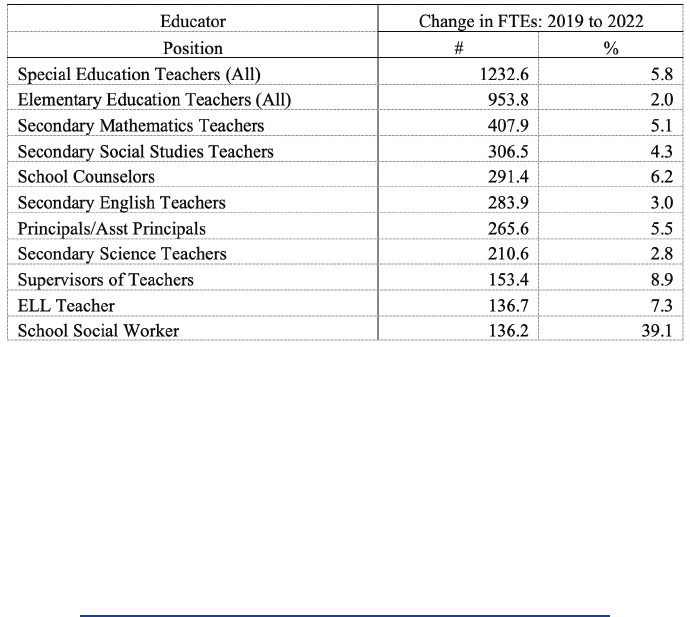
16 Penn State College of Education Center for Education Evaluation & Policy Analysis
Table 1: Increase in Pennsylvania Educator FTEs in All Positions
with an Increase Greater than 100 Teacher FTEs (2018 to 2022)
Data source: Author’s analysis of PDE educator employment files
Because of this greater stress on the supply of
teachers, the number of positions lled with
teachers on emergency permits has increased over
this time period. For example, there have been
increases in the number of emergency permits
for special education teachers (+394), elementary
teachers (+403), English Language Learner
teachers (+18), computer science teachers (+44),
English language arts teachers (+71), and social
studies teachers (+19).
Impact of Teacher Stang Challenges
The greatest impact of teacher stafng challenges
is felt by high-need schools — those serving high
proportions of students in poverty and students
of color. While these schools always have greater
difculty than other schools in recruiting and
retaining well-prepared and effective teachers,
in times of constrained supply and high demand,
such schools experience greater difculties in
hiring and retaining teachers. The most direct
evidence of this effect is the number of vacancies
and number of applicants across different types
of schools. Because states typically do not collect
such information, researchers rely on proxies for
these measures — typically the percentage of
novice teachers and school-level teacher turnover.
As shown in Figures 16 and 17, Pennsylvania
schools with the greatest percentages of students
living in poverty and students of color have
substantially greater percentages of novice
teachers (teachers with three or fewer years of
experience). The differences were particularly
large at the middle school level. Strikingly, more
than one out of every ve middle school teachers
employed in the quintile of schools with the
greatest percentage of students living in poverty
had three or fewer years of teaching experience.
For the middle schools with the greatest percentages of
students of color, nearly one in four teachers had less than
three years of experience.
This strongly suggests such schools have much
greater difculty in recruiting and retaining
teachers.
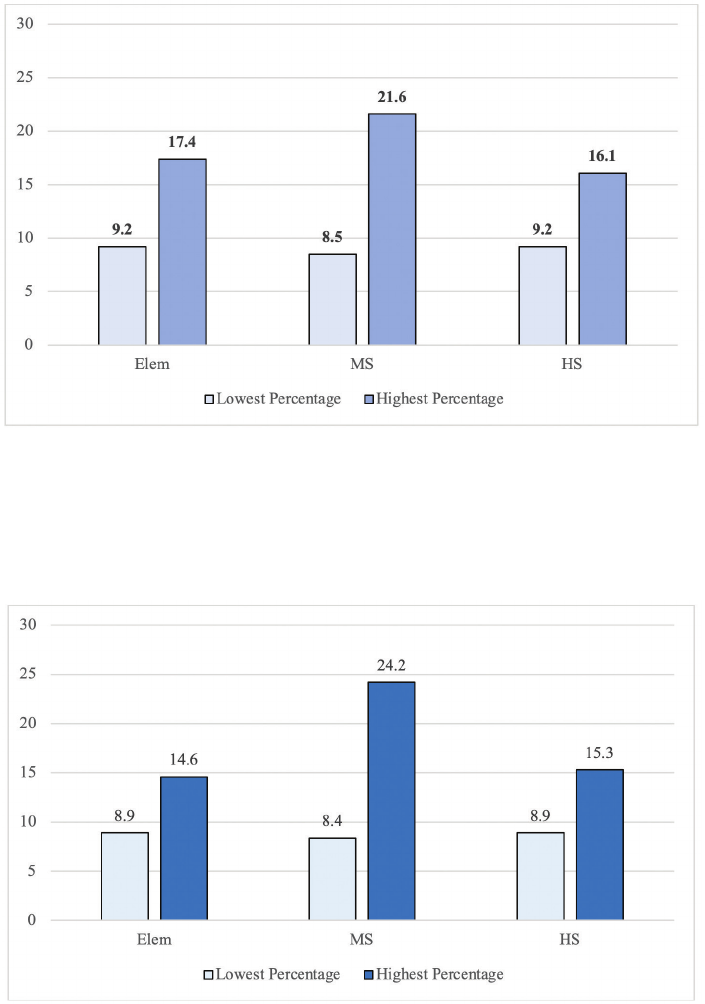
Penn State College of Education Center for Education Evaluation & Policy Analysis 17
Figure 16: Percentage of Novice Teachers for the Lowest and Highest Quintiles
of Students of Living in Poverty Enrolled in the School and School Level (2014-2022)
Data source: PDE educator employment files; PDE Future Ready data; analysis by author
Figure 17: Percentage of Novice Teachers for the Lowest and Highest Quintiles
of Students of Color Enrolled in the School and School Level (2014-2022)
Data source: PDE educator employment files; PDE Future Ready data; analysis by author
Similarly, as shown in Figures 18 and 19,
Pennsylvania schools with the greatest
percentages of students living in poverty and
students of color have substantially greater
teacher turnover (percentage of teachers leaving
the school).
Again, the greatest differences were particularly
large at the middle school level. For middle
schools enrolling the greatest percentages of
students living in poverty, more than one out of
every ve teachers leaves the school every year.
For middle schools enrolling the greatest percentages of
students of color, one out of every four teachers leaves the
school each year.
These results also strongly suggest such schools
have much greater difculty in recruiting and
retaining teachers.
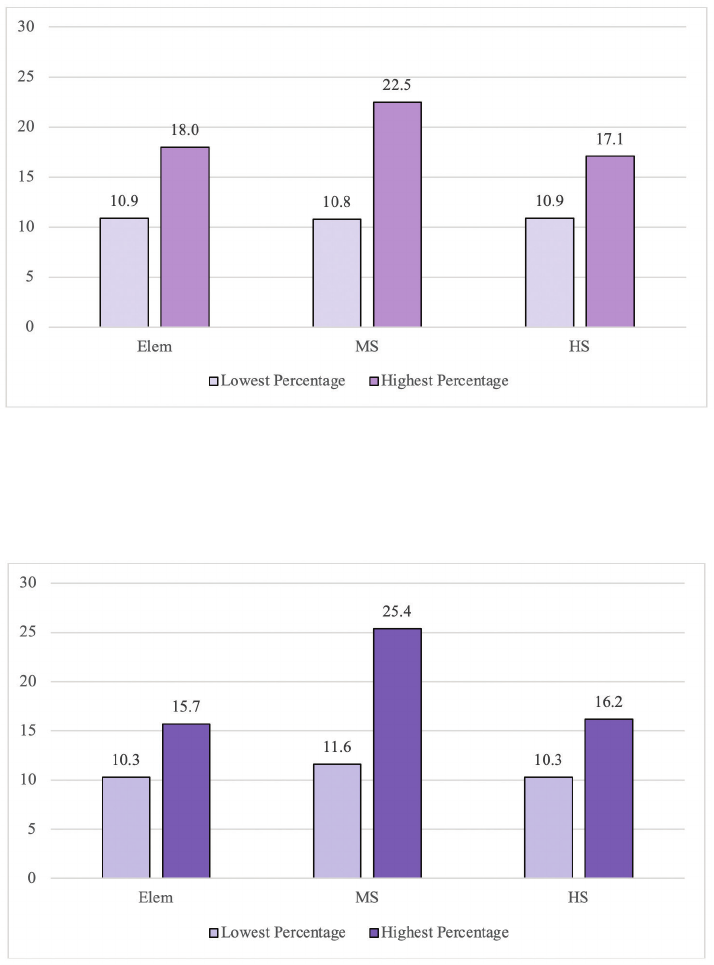
18 Penn State College of Education Center for Education Evaluation & Policy Analysis
Figure 18: Percentage of School Level Teacher Turnover by the Lowest and Highest Quintiles
of Students of Living in Poverty Enrolled in the School and School Level (2014-2022)
Data source: PDE educator employment files; PDE Future Ready data; analysis by author
Figure 19: Percentage of School Level Teacher Turnover by the Lowest and Highest Quintiles
of Students of Color Enrolled in the School and School Level (2014-2022)
Data source: PDE educator employment files; PDE Future Ready data; analysis by author
These differences are important because inexperienced teachers (Fuller & Pendola, 2020; Podolsky,
Kini, & Darling-Hammond, L. 2019) and teacher turnover (Fuller & Pendola, 2020; Nguyen, et al., 2019)
both have negative effects on student outcomes.
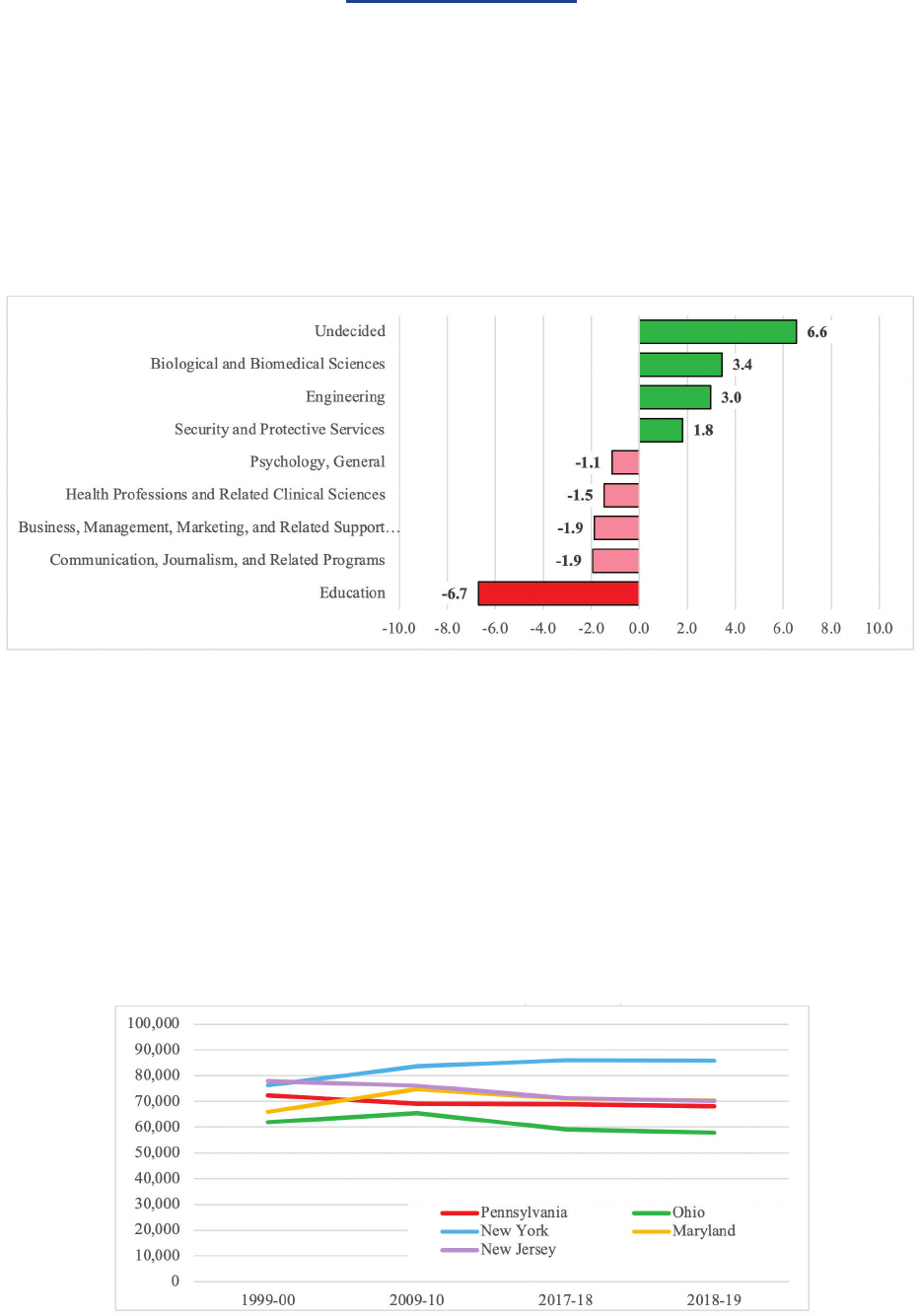
Penn State College of Education Center for Education Evaluation & Policy Analysis 19
Potential Causes
Unfortunately, we do not have a rm grasp of the
causes of the decline in enrollment and graduation
from teacher preparation programs.
As shown in Figure 20, potential teachers appear
to be making decisions about entering the
profession prior to college. Indeed, the percentage
of Pennsylvania high school students taking the
SAT and indicating an intent to major in education
declined from 11.2% in 2009 to just 4.5% in 2019.
The decline of 6.7 percentage points was by far
the greatest decline of all majors included on the
survey.
Figure 20: Change in the Percentage of Student Reported Intended Majors on SAT (2009 to 2019)
Data source: SAT College Bound Seniors Report for Pennsylvania (2009 and 2019); calculations and graphs by author
One possible explanation is stagnant teacher
salaries that have declined relative to ination and
salaries for other occupations requiring a college
degree.
For example, according to the National Center for
Education Statistics, the average annual wage for
public school teachers in Pennsylvania in constant
2019 dollars declined by almost 6% from 2000 to
2019 (See Figure 21 below). This occurred during a
20-year period in which the buying power of $100
declined by nearly 50%. Thus, teacher salaries buy
signicantly less than they did 20 years ago.
Figure 21: Average Annual Teacher Wages for Pennsylvania and Surrounding States
in Constant 2019 Dollars (2000-2019)
Data source: National Center for Education Statistics (2019) Estimated average annual salary of
teachers in public elementary and secondary schools, by state: Selected years, 1969-70 - 2018-19
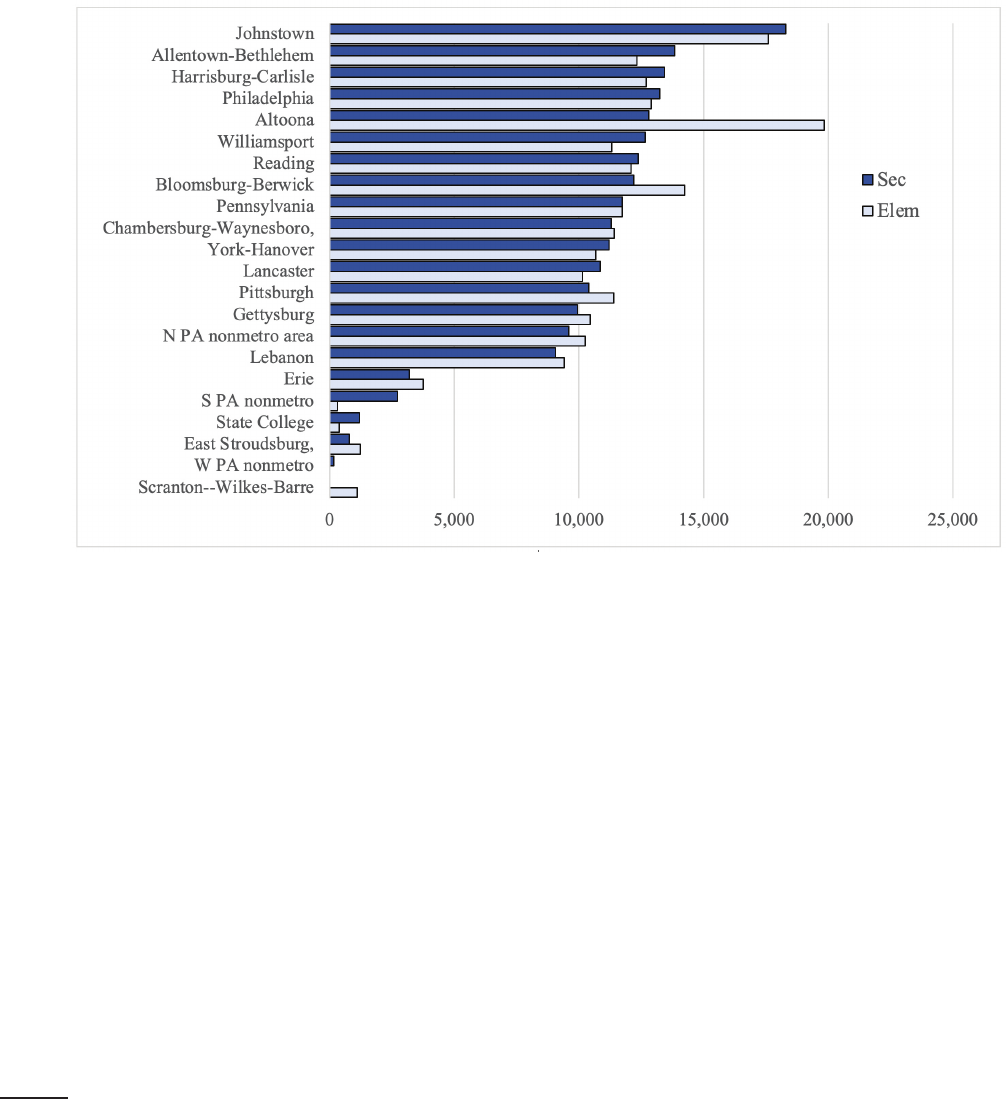
20 Penn State College of Education Center for Education Evaluation & Policy Analysis
In addition, for employees earning wages at the
10
th
percentile in their occupation, teachers make
substantially less than registered nurses in most
areas of Pennsylvania (See Figure 22 below).
If the 10
th
percentile serves as a proxy for entry-
level wages, there is little economic incentive for
an individual to enter the teaching profession.
Figure 22: Dierence in Salaries of Teachers and Registered Nurses
at the 10th Percentile or Pennsylvania Regions (2021)
i
Data source: Bureau of Labor Statistics Occupational Employment and Wage Statistics, 2021; analysis by author
i
The data were drawn from the U.S. Bureau of Labor Statistics Occupational Employment and Wage Statistics. The data
includes wages for all teachers, regardless of employment in a public or private school. Data for special education teachers
and Career and Technical Education (CTE) teachers were not included as many of the labor markets did not have wages
reported for these teachers due to smaller sample sizes. Special education wages do not vary signicantly from regular
education teacher wages. CTE teacher wages are generally greater than regular teacher wages. However, small sample sizes
makes comparisons difcult and potentially misleading using this data.
Another possible explanation is a growing
negative perception about the working conditions
of teachers. With the growth of social media,
high school students are likely to have far more
access to negative claims about teaching and even
attacks on teachers from parents and politicians.
In comparison to other states, Pennsylvania
teachers report their working conditions are very
slightly below average (Learning Policy Institute,
2018). Choosing a profession with stagnant pay
and the possibility of being denigrated for your
work certainly inuences individuals’ decisions to
enter the teaching profession.
Another factor in Pennsylvania is that it has
historically been difcult to nd a teaching job in
the state. When 15,000 individuals were obtaining
certication, there were not a sufcient number of
jobs for everyone in Pennsylvania schools. Many
graduates had to choose another profession or
move out of state.
We have a much better understanding of the
causes of attrition. While attrition is not the
primary cause of the shortage, attrition does
play a signicant role. After personal factors
such as moving or pregnancy, researchers have
consistently concluded that salary and working
conditions are the two factors most strongly
associated with teacher’s decisions to quit the
profession (Nguyen, et al., 2019).

Penn State College of Education Center for Education Evaluation & Policy Analysis 21
Adopt teacher pay raises
Teacher salaries certainly impact teacher supply and demand and an increase in salaries is likely to
have some impact on teacher stafng challenges. Increases in early career wages would have the
greatest impact on recruitment of individuals into the profession. Targeted raises for teachers to work
and remain in hard-to-staff schools and subject areas tends to be the most effective strategies. There
are, however, political barriers to adopting differentiated pay strategies.
Create teacher scholarship and loan forgiveness programs
A number of states have created teacher scholarship and loan forgiveness programs that make
obtaining teacher certication much more affordable — especially for lower income students and
students of color. PDE should conduct a through review of such programs or contract for a review and
report on such programs to ensure the Commonwealth adopts the most appropriate strategies. This
would potentially increase the number of individuals entering teaching as it would have a positive
impact on the cost-benet calculation regarding entering the teaching profession.
Implement a statewide teacher working conditions survey
Researchers have consistently found teacher working conditions greatly inuence teacher attrition and
turnover (Nguyen, et al., 2019). Administrators, however, often do not fully grasp teacher perceptions
of working conditions and often over-estimate the degree to which teachers hold positive perceptions
of their working conditions and, especially, the behaviors of school leaders. Implementing a statewide
teacher working conditions survey will provide administrators with vital information that will help them
address teachers’ concerns and hopefully reduce teacher attrition. There are a number of excellent
examples of such surveys. Ideally, the surveys of teachers would be coupled with student surveys like
the surveys administered in Alabama around 2010.
Fund a statewide advertising campaign to elevate perceptions of the teaching profession
To counteract the impact of negative information about the teaching profession, the state and
organizations supportive of public education should fund a coordinated media campaign that
communicates the positive aspects of being a teacher.
Support the expansion of Future Teachers of America programs
The Pennsylvania Department of Education should support and facilitate the expansion of the Future
Teachers of American program in middle schools and high schools across the state.
Support the expansion of the Black Teacher Project across the state
The Black Teacher Project has already had a positive impact on the Black teacher pipeline. Their
expansion of work across the Commonwealth should be supported.
Potential Solutions
Adopting solutions without fully understanding
the underlying root causes of teacher stafng
challenges can be dangerous. Policies that are
adopted but that do not actually target the
root causes will be unsuccessful. Given this
caution, research strongly suggests that the
recommendations below would lessen the teacher
stafng challenges currently faced by school
districts in Pennsylvania.

22 Penn State College of Education Center for Education Evaluation & Policy Analysis
Conduct a Comprehensive Review of Teacher Preparation Policies
PDE should review or contract with organization(s) to review the policy environment around teacher
preparation in the Commonwealth. The review should consider how policies facilitate or impede the
quality preparation of individuals for teaching positions in the Commonwealth. The review should also
examine Grow Your Own Programs and other quality alternative pathways.
Adopt a Teacher Preparation Program Quality Review Eort
PDE should create a teacher preparation program quality review effort that includes analysis of state
administrative data, surveys of teacher preparation program graduates, surveys of employers of
graduates of teacher preparation programs, and periodic in-person program reviews.
Create a New Data Collection and Analysis Plan
PDE should collaborate with organizations and individuals to conduct a comprehensive review of
current educator workforce data collection and analysis efforts and propose a new system that would
provide detailed and actionable data. This is necessary to better understand the issues underlying
various issues regarding teacher supply, demand, and stafng challenges.
Support Dierentiated Career Advancement
To obtain a substantial increase in salary, teachers must either transfer to a higher paying district or
enter into another job role such as counselor or administrator. However, many teachers prefer not to
leave the classroom. Supporting pay increases for teachers to advance into formal Teacher Leader
positions associated with greater pay for greater responsibilities would help create pathways to greater
salaries as well as reduce the substantial time burden on school leaders which is a primary cause of the
20% annual turnover rate for principals.
Summary
Given the available evidence, the primary cause
of teacher stafng challenges in Pennsylvania is
an inadequate supply of newly certied teachers.
Indeed, the number of individuals graduating
from Pennsylvania teacher preparation programs
and obtaining teacher certication has declined
more than 60%. While student enrollment has
declined, the decline in newly certied teachers
far surpasses the decline in student enrollment.
A secondary cause is the hiring of more than
3,000 additional educators since the 2017-18
school year. Much of this hiring is in response to
the needs of students after the rst two years of
the COVID-19 pandemic. While helping students
recover from the pandemic, the increase in hiring
despite a decline in student enrollment has
further stressed the already fragile teacher supply
and demand balance. Teacher attrition has only
a minimal effect on teacher stafng challenges.
While charter schools have an extraordinarily
high attrition rate, most schools in Pennsylvania
have attrition rates substantially lower than the
national teacher attrition rate of 8%.
Given the available evidence, state and local
policymakers must understand the causes of the
decline in the number of individuals obtaining
teacher certication and craft policies and
strategies that increase the number of individuals
entering teacher preparation programs.
Policymakers should be careful in adopting
strategies without fully understanding the root
causes of the problem.

Penn State College of Education Center for Education Evaluation & Policy Analysis 23
References
Clotfelter, Charles T., Ladd, Helen F., Vigdor, Jacob L., 2010. Teacher credentials and student achievement in high school: a
cross-subject analysis with student fixed eects. Journal of Human Resources 45(3): 655–681
Fuller, E. & Pendola, A. (2020). K-12 teacher supply, demand, and shortages in Pennsylvania. Center for Rural Pennsylvania.
https://www. rural.palegislature.us/documents/reports/PA-Teacher-Supply-Demand-Shortages-2020. pdf.
Goldhaber, D. (2012). Teachers matter, but eective teacher quality policies are elusive. In Handbook of research in education
finance and policy (pp. 168-187). Routledge.
Jacob, B. A. (2016). The power of teacher selection to improve education. Evidence Speaks Reports, 1(12), 1-7.
Kelly, S., & Northrop, L. (2015). Early career outcomes for the “best and the brightest” selectivity, satisfaction, and attrition in
the beginning teacher longitudinal survey. American Educational Research Journal, 52(4), 624-656.
Learning Policy Institute (2018). Understanding Teacher Shortages: 2018 Update. Retrieved on September 24th from https://
learningpolicyinstitute.org/product/understanding-teacher-shortages-interactive
Nguyen, T. D., Pham, L., Springer, M. G., & Crouch, M. (2019). The Factors of Teacher Attrition and Retention: An Updated and
Expanded Meta-Analysis of the Literature. Annenberg Institute at Brown University, 19-149.
Podolsky, A., Kimi, T., & Darling-Hammond, L. (2019). Does teaching experience increase teacher eectiveness? A review of
US research. Journal of Professional Capital and Community.
